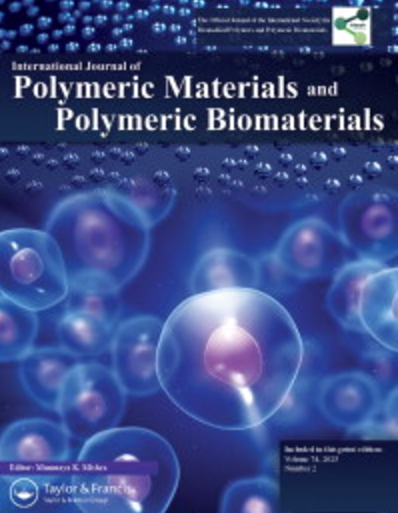Preparation of elastic hydrogel films via in-situ ketalization of Poly(vinyl alcohol) and ZnO nanoparticle doped Poly(vinyl ketal) films as antibacterial surface
IF 2.6
4区 医学
Q4 MATERIALS SCIENCE, BIOMATERIALS
International Journal of Polymeric Materials and Polymeric Biomaterials
Pub Date : 2023-08-24
DOI:10.1080/00914037.2023.2250048
引用次数: 0
Abstract
Abstract Cross-linked and flexible poly(vinyl acetone ketal) (PV-A-K) films have been prepared as a result of ketalization reaction and monolith formation of poly(vinyl alcohol) (PVA), which has the feature of forming films quickly and is frequently used in biological fields. In this novel method, flexible PV-A-K films have been produced simply and in a short time accompanied by monolith formation without any catalyst in acetone. The effect of acetone ratio on the physical properties (i.e., swelling and mechanical properties) of such formations has been investigated to reveal significant influences of it. In addition, zinc oxide (ZnO) nanoparticles synthesized via the solvothermal method have been doped into PV-A-K films during film preparation. The prepared PV-A-K and ZnO doped PV-A-K films have been characterized with SEM, XRD, and FT-IR. Their mechanical properties have been investigated with a universal mechanical test machine. The acetone ratio is quite effective both on the porosity and stress/strain properties of the films. Antibacterial activities of the films are evaluated against four different strains (E. coli, S. aureus, P. aeruginosa, and E. faecalis) via the disk diffusion method. The films are selectively effective against S. aureus. These highly flexible and elastic films have great potential for biomedical applications, wound dressing, and antibacterial surface preparation. Graphical Abstract聚乙烯醇原位酮化制备弹性水凝胶膜,纳米ZnO掺杂聚乙烯醇薄膜作为抗菌表面
本文章由计算机程序翻译,如有差异,请以英文原文为准。
求助全文
约1分钟内获得全文
求助全文
来源期刊

International Journal of Polymeric Materials and Polymeric Biomaterials
Chemical Engineering-General Chemical Engineering
CiteScore
8.00
自引率
3.10%
发文量
97
审稿时长
3.3 months
期刊介绍:
International Journal of Polymeric Materials and Polymeric Biomaterials is the official publication of the International Society for Biomedical Polymers and Polymeric Biomaterials (ISBPPB). This journal provides a forum for the publication of peer-reviewed, English language articles and select reviews on all aspects of polymeric materials and biomedical polymers. Being interdisciplinary in nature, this journal publishes extensive contributions in the areas of encapsulation and controlled release technologies to address innovation needs as well.
 求助内容:
求助内容: 应助结果提醒方式:
应助结果提醒方式:


